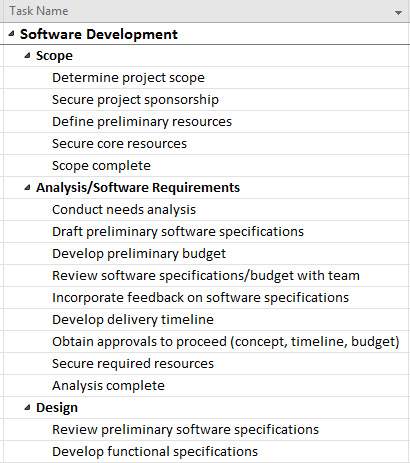Here are the tips
Quite often you’ll only ever see the WBS as it is presented here, as an output of Microsoft Project, Primavera or other software utility.
However, given the complexity and criticality of the work breakdown structure, experienced project managers will always prepare their WBS on paper first, before loading it into software.
To make sure you include everything, consult widely with your stakeholders on project requirements. WBS building should ultimately be a team activity.

And here’s a great tip for preparing your WBS – use sticky notes!
Have the group brainstorm project tasks, but instead of writing them on a whiteboard or flipchart, jot them down on sticky notes.
You might approach this from the top down by starting with the project charter and asking OK, what do we need to do to complete that… and that… etc.
Or you might brainstorm from the bottom up, saying OK, we know we have to complete all these little tasks; how might we group them?
The advantage of using sticky notes is flexibility.
It is easy to move notes around, add, subtract, or edit notes; or consider alternative strategies for structuring the project.
Just make sure you only place one task on each note.
Here are the tricks
1. You should also use verbs (action words) to clarify what is required at each step and to focus attention on the deliverable.
For example, the high-level WBS illustrated in the last topic is better expressed as follows:
- Prepare plans
- Acquire finance
- Pour foundations
- Connect power and water
- Construct walls and roof
- Finish interior
- Landscape grounds
2. When preparing a WBS, we sometimes also get so caught up in the detail of the deliverable we forget that there is project management work to do as well!
This might include inducting and training project team members, reporting to stakeholders, preparing those reports, and reviewing the project when it is complete.
Each of these activities will take time (which someone will probably have to be paid for), and other resources too.
3. The 100% rule of project planning states that you should include all the work required and nothing that isn’t.
Sounds a bit too obvious?
Well, because all subsequent planning is based on the WBS, when you discover – too late – that you’ve forgotten a task, you probably won’t have any time or money to complete it.
This can be a project killer.
Similarly, because the WBS is a complete statement of work, you are wasting time and money and potentially stepping on someone else’s toes if you include activities you’re not supposed to do.
After all, our theory of triple constraints tells us that the more complex our scope is, the harder it is to achieve quality with finite time and resources.
4. Some organizations and project managers go to the trouble of preparing a formal scope statement to act as an executive summary for the WBS.
This may be a useful means of communicating the project work requirements to stakeholders at a greater level of detail than might otherwise be found in the Project Charter (for example, by category), but is really only necessary on large or more complex projects.




